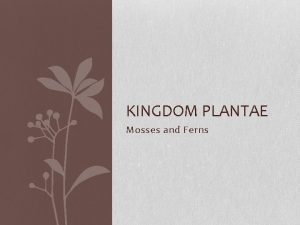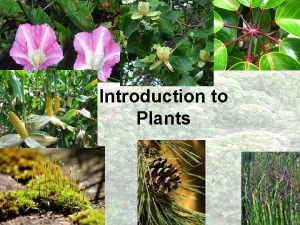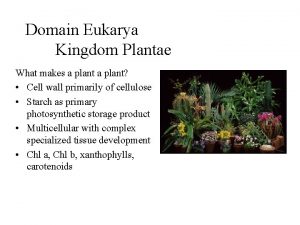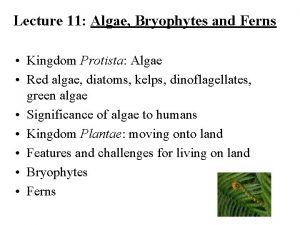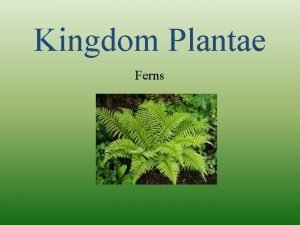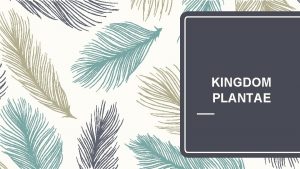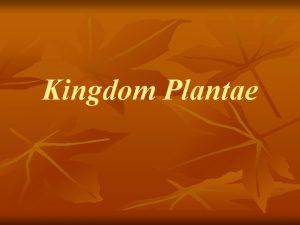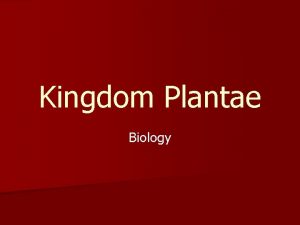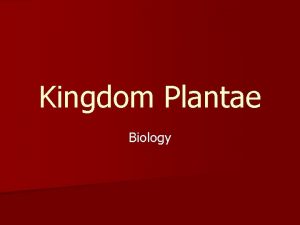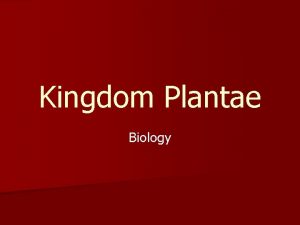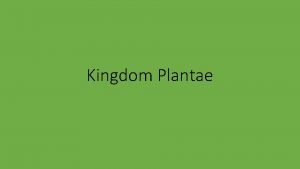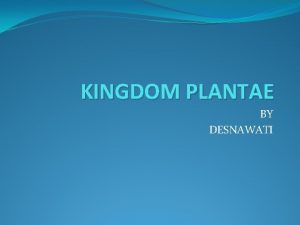Kingdom Plantae The World of plants Plants People

















- Slides: 17

Kingdom Plantae The World of plants

Plants & People 35, 000 plant species People use at least 10, 000 20 plant species provide more than 90% of our food supply – 3 make up more than ½ of daily calories (wheat, rice, corn, )

Food Crops Cereals Root crops Legumes Fruits, vegetables, & nuts Spices, herbs, flavorings Food production

Nonfood Uses of Plants Medicine Clothing & fabric dyes Fuel Table 27 -3 – Identify three plants from the table that are common food plants but are used for other purposes.

Plants General characteristics of plants – Eukaryotes – Multicellular – Autotrophs- produces their own food Contain chloroplasts where food production takes place. Chloroplasts contain chlorophyllgives the plant its color

Chloroplast


Adaptations of Plants Adaptation – Seed & Spores allow widespread dispersal Seeds more effective at dispersal – Cuticle- a waxy, protective layer on the leaves and stems. Helps prevent water loss Stomataopening in the cuticle


Cuticle and stomata

Adaptations of Plants Adaptation – Vascular tissue Xylem- absorbs water & inorganic nutrients from the roots to the stems & leaves. Phloem- carries organic compounds (ex. carbohydrates) to other places of the plant.


Adaptations of Plants Leaf- a broad flat organ – Food production takes place here (photosynthesis) Roots anchor the plant – helps absorb water and nutrients for the plant.

Classifying Plants Nonvascular Plants – No vascular tissue (xylem & phloem), roots, stems, or leaves – Grow on land near streams & rivers Bryophyte, liverwort, hornwort

Classifying Plants Vascular Plants – Have vascular tissue – Seedless Plants Release spores Ferns, moss, horsetails – Seed Plants Greater chance of reproductive success

Roots, Stems, Leaves Roots – Anchor the plant, absorb & transport water & nutrients (taproot & fibrous root) Stems – Support leaves, transport materials, provide storage Leaves – photosynthesis

Roots and Leaves
 Are protists eukaryotic
Are protists eukaryotic What do kingdom fungi and kingdom plantae share
What do kingdom fungi and kingdom plantae share Protista domain
Protista domain Old kingdom middle kingdom new kingdom
Old kingdom middle kingdom new kingdom Old kingdom middle kingdom new kingdom
Old kingdom middle kingdom new kingdom Roman empire
Roman empire Mentohotep
Mentohotep Phylogenetic tree of kingdom plantae
Phylogenetic tree of kingdom plantae Characteristics of filicinophyta
Characteristics of filicinophyta Plant kingdom
Plant kingdom Plantae kingdom
Plantae kingdom What is plantae domain
What is plantae domain Protista, fungi, plantae, animalia *
Protista, fungi, plantae, animalia * Dunia plantae
Dunia plantae Kingdom characteristics chart
Kingdom characteristics chart Kingdom animalia eukaryotic or prokaryotic
Kingdom animalia eukaryotic or prokaryotic Benefits of algae
Benefits of algae Kingdom animalia cladogram
Kingdom animalia cladogram








